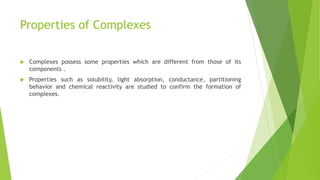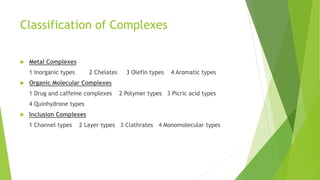complexation.pptx
- 1. Complexation And its applications Kashish Wilson Assistant Professor,MM(DU) Mullana, Ambala
- 2. Complex Compounds Complex compounds are defined as those molecules in which most of the bonding structures can be described by classical theories of valency between atoms but one or more of these bonds are anomalous . The intermolecular forces involved in the formation of complexes are : Covalent or co - ordinated bonds Van der waals forces Ion-dipole , dipole-dipole interactions Hydrogen Bonding
- 3. Properties of Complexes Complexes possess some properties which are different from those of its components . Properties such as solubility, light absorption, conductance, partitioning behavior and chemical reactivity are studied to confirm the formation of complexes.
- 4. Applications of complexes in pharmacy Physical state can be altered with complex formation for processing tasks e.g nitroglycerine can be transformed to crystalline inclusion complex with Beta cyclodextrin. Volatility can be reduced to increase stability or reduce bad odour e.g formulation of iodine as a complex with polyvinyl pyrrolidone (PVP) . Solid state stability can be enhanced e.g Beta cyclodextrin complexes of vitamin A and D are stabilized chemically. Chemical Stability can be altered e.g rate of hydrolysis of benzocaine can be reduced by complexing it with caffeine. Solubility can be enhanced e.g at low concentrations caffeine enhances the solubility of P-amino benzoic acid (PABA) .
- 5. Applications of complexes in pharmacy Dissolution can be improved e.g dissolution rate of phenobarbital is enhanced by cyclodextrin inclusion complexes . There are many other uses of complexes in pharmacy Absorption and Availability Reduced Toxicity Antidote Antibacterial Activity
- 6. Some important complexes available as drugs Cisplatin Pvidone Iodine
- 7. Classification of Complexes Metal Complexes 1 Inorganic types 2 Chelates 3 Olefin types 4 Aromatic types Organic Molecular Complexes 1 Drug and caffeine complexes 2 Polymer types 3 Picric acid types 4 Quinhydrone types Inclusion Complexes 1 Channel types 2 Layer types 3 Clathrates 4 Monomolecular types






